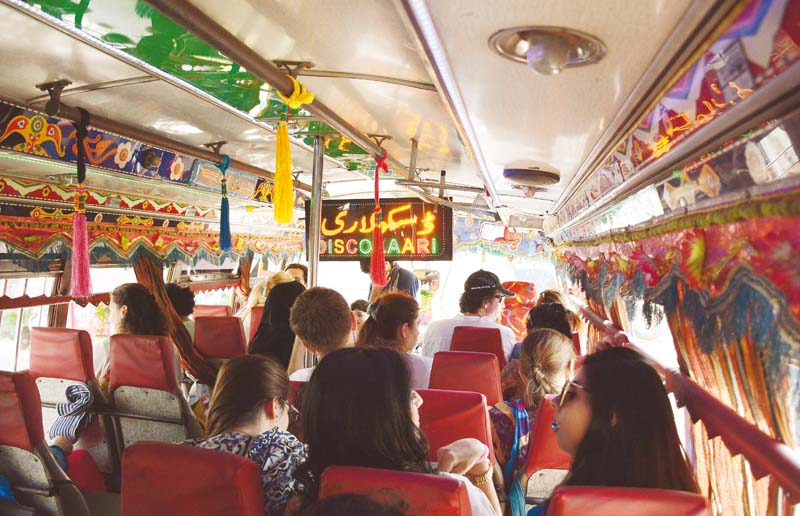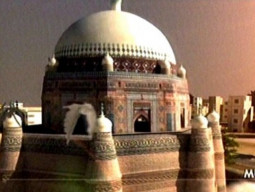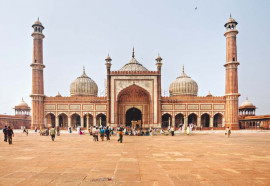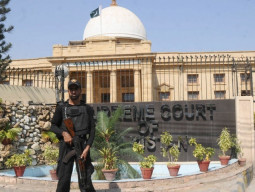
The full-sized open bus, decorated with rainbow lights and multicolored bunting hanging from the ceiling, is set to begin its much-awaited tour of Rawalpindi’s heritage sites. The tour guide tries working the sound system but there is a technical glitch. Unfortunate, since he had arranged a line-up of upbeat, Pakistani songs to go perfectly with the vibe in the bus.

The Khem Singh Haveli constitutes 22 rooms and three basements, and has four storeys. PHOTOS : HUMA CHOUDHARY

The entrance to Rawat Fort. PHOTOS : HUMA CHOUDHARY
“Dekhne main bholi, chalne main goli”, Disco Laari, is the first initiative organised by Keys Foundation, in collaboration with Clippings, to discover abandoned heritage sites in Rawalpindi and its outskirts. Travel enthusiasts, who had registered for the trip beforehand, assembled at Fatima Jinnah Park’s parking lot for this journey, which begins via the Grand Trunk Road as soon as all the participants arrive.
“We work on heritage and peace-building and Disco Laari is one of the many initiatives we’re working on,” shares Sarmad Saeedy, CEO of Keys Foundation, a non-profit organisation. The idea is to raise awareness about these archaeological assets and work on their preservation, he adds.

The entrance to Khem Singh Haveli, constructed by Baba Khem Singh Bedi in the late nineteenth century. PHOTOS : HUMA CHOUDHARY

Rawat Fort from the inside. PHOTOS : HUMA CHOUDHARY
The ride is bumpy and airy, giving a real feel of a laari (lorry), as the bus passes through different bazaars and landmarks in Rawalpindi. The first stop is Mankiala Stupa, which is located off Rawat Road, approximately 30 kilometers from Islamabad.
According to archaeologists and historians, the Mankiala Stupa dates back to the Gandhara period. One of the most fascinating tales about Mankiala Stupa is that Buddha sacrificed some of his body parts at this place to feed hungry tiger cubs. It is made out of red stones and has a protective iron grill around it. However, it is in dire need of restoration, as excessive wild grass and shrubs grow all around the stupa.
“Chalain jee chalain,” yells the energetic conductor after about 30 minutes. The bus covers another 30 kilometers from Rawat, while food vendors eagerly offer items through the bus windows each time the vehicle stops or slows down. We reach Kallar Sydean, a small town where the Khem Singh Haweli, our next stop, is located. A short walk through the local market takes one to the haveli. The eye-catching fresco work immediately grabs the visitors’ attention as they step inside the carved wooden door.

Mankiala Stupa is the first stop on the tour. PHOTOS : HUMA CHOUDHARY
Constructed by Baba Khem Singh Bedi in the late nineteenth century, the ancient structure constitutes of 22 rooms and three basements and has four storeys. Despite their dilapidated condition, the stunning jharokas (overhanging enclosed balconies) are a treat to look at. The rooms are adorned with paintings depicting Sikh gurus, saints, and heroes of the Khalsa movement of Guru Gobind Singh.
Lunch and drinks are included in Disco Laari’s Rs1,500 fare and are served at a public school located adjacent to the haveli. The spicy biryani further enriches the cultural experience.
After lunch, the last stop is Rawat Fort. Located on the outskirts of Rawalpindi in Pothohar, the fort was constructed in the early 16th century by Gakhars, a designated warrior clan raised by local tribes to defend the Pothohar plateau. Apart from the walls and chambers within the building, the two main attractions are the mosque and the octagonal single-domed mausoleum. In the courtyard of the fortress lie scattered graves, including those of Sarang Khan and his 16 sons, who died here during battle.
“I have been in Islamabad for two years but haven’t been able to see these historic monuments on my own,” shares one laari passenger Harry Hoste. “The tour was a tremendous experience for my wife and I; we learnt a lot about this area,” he adds.
Nimre Shahzada, another participant, says, “It’s a brilliant project, but more tours should be organised during the winter. It’s a hot day and one doesn’t enjoy the tour as much as they should due to the scorching heat.”
The tour ends around 5:30pm and gives you a taste of the region’s culture and heritage. It is organised every other weekend, with photo walks held on the weekends in between. The overall experience is a must-have for all travel enthusiasts.
Huma Choudhary is a photojournalist working for The Express Tribune in Islamabad.
Published in The Express Tribune, Sunday Magazine, September 27th, 2015.










































COMMENTS (1)
Comments are moderated and generally will be posted if they are on-topic and not abusive.
For more information, please see our Comments FAQ